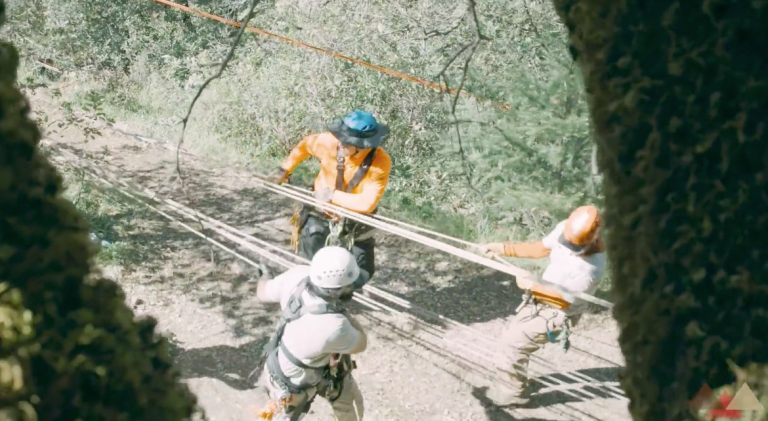In rope rescue, the true test of skills comes in real-world applications where every knot and force-multiplying system plays a critical role. Whether in fire service or search and rescue (SAR), the stakes are high, and the right choice of knots and force multipliers can mean the difference between success and failure. This final part of our series takes a look at practical examples from the field, highlighting how these essential elements come together to create safe, efficient, and effective rope rescue systems. Each case demonstrates the importance of combining knowledge, experience, and technical precision to solve complex rescue challenges.
Key Real-World Applications for Knots and Force Multipliers in Rope Rescue
1. Vertical Evacuations in High-Rise Fire Rescues
Vertical evacuations are challenging, especially in fire rescue operations within high-rise buildings. Using mechanical advantage systems with knots like the figure-eight follow-through and double loop figure-eight ensures controlled descents and effective force distribution, enabling rescuers to lower individuals safely from significant heights.
- Figure-Eight Follow-Through: Ideal for secure, controlled descents, especially when lowering victims over vertical distances.
- Double Loop Figure-Eight: Provides stability and reduces risk of rope slippage, making it a reliable choice for handling significant loads.
Why It Matters: Vertical rescues demand precision and control, and the right knot choice maximizes the system’s effectiveness while ensuring the safety of both rescuers and those they’re assisting.
2. High-Angle Cliff Rescues in SAR
Search and rescue teams frequently operate in rugged terrains like cliffs, where high directional setups and knots like the alpine butterfly and bowline on a bight are crucial for managing angles and distributing force safely.
- Alpine Butterfly: Perfect for handling directional changes mid-line, this knot allows for safe navigation of sharp angles.
- Bowline on a Bight: Ensures stable, reliable anchors in variable terrain, offering the flexibility needed for high-angle rescues.
Why It Matters: In SAR, the ability to maintain stability on challenging angles is essential. These knots and force multipliers provide the support needed to navigate complex landscapes safely.
3. Confined Space Rescues in Industrial Environments
Industrial rescues often involve confined spaces, requiring high security and adaptable knots. Using a prusik knot for self-rescue capabilities and mechanical advantage systems for lifting are common techniques, allowing for efficient movement within restricted spaces.
- Prusik Knot: Allows for quick adjustments and secure grip, providing flexibility for confined and challenging spaces.
- 3:1 Mechanical Advantage System: Reduces effort in tight areas, enabling effective victim extraction with limited space and access.
Why It Matters: Confined space rescues call for adaptable, secure setups. These systems and knots allow rescuers to navigate small, restricted areas while maintaining control and minimizing risk.
4. Swiftwater Rescue Operations
In swiftwater rescues, handling moving loads in a constantly shifting environment is key. Knots like the double fisherman’s knot and münter hitch are crucial for securing lines across the water, while mechanical advantage systems stabilize the load against the current.
- Double Fisherman’s Knot: Provides a secure connection in wet conditions, ideal for lines under tension in swiftwater.
- Münter Hitch: Versatile and easily adjustable, this hitch allows rescuers to manage changing conditions in real time.
Why It Matters: Swiftwater rescues require flexibility and strong, reliable connections. These knots and force multipliers offer the stability needed to handle dynamic, unpredictable conditions.
5. Rescue Tower Operations for High-Altitude Workers
In scenarios involving tower rescues for industrial or utility workers, stability and control are paramount. Using tensioned track systems (TTRS) with the alpine butterfly for load balancing helps ensure safe, efficient descent and ascent.
- Alpine Butterfly: Provides a reliable mid-line connection point, essential for handling loads on tensioned track systems.
- 5:1 Mechanical Advantage System: Allows for controlled ascent and descent, distributing force across multiple points for stability.
Why It Matters: High-altitude rescues demand precision and controlled movement. The combination of TTRS and reliable knots enables rescuers to perform with confidence and security in elevated environments.
Conclusion: Putting Knowledge into Practice with Knots and Force Multipliers
Each of these real-world applications demonstrates the essential role of knots and force multipliers in rope rescue. By understanding how these components work together, rescue teams can tackle complex scenarios with confidence, precision, and safety. From high-rise evacuations to confined space rescues, the right choice of knots and mechanical advantage systems makes all the difference in achieving successful outcomes. Through practice and continued learning, rescue teams in fire service and SAR can hone these skills, ensuring that they’re ready for the challenges of real-world rescue operations.
- Knots and Force Multipliers in Anchor Systems(Opens in a new browser tab)
- Force Multipliers and The Fundamentals of Mechanics(Opens in a new browser tab)
- 4 Fundamentals of Force Multiplier Mechanics(Opens in a new browser tab)
- The Hierarchy of Rope Rescue Learning Pathway(Opens in a new browser tab)
- Why Fire Services Should Embrace Rope Rescue Technical Online Training(Opens in a new browser tab)
Peace on your Days
Lance










